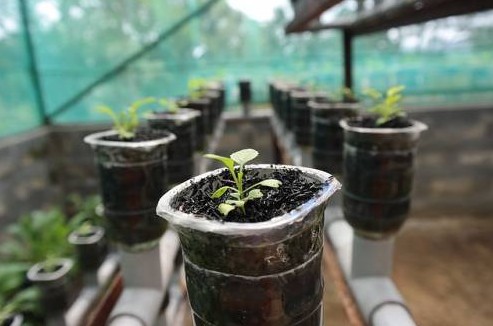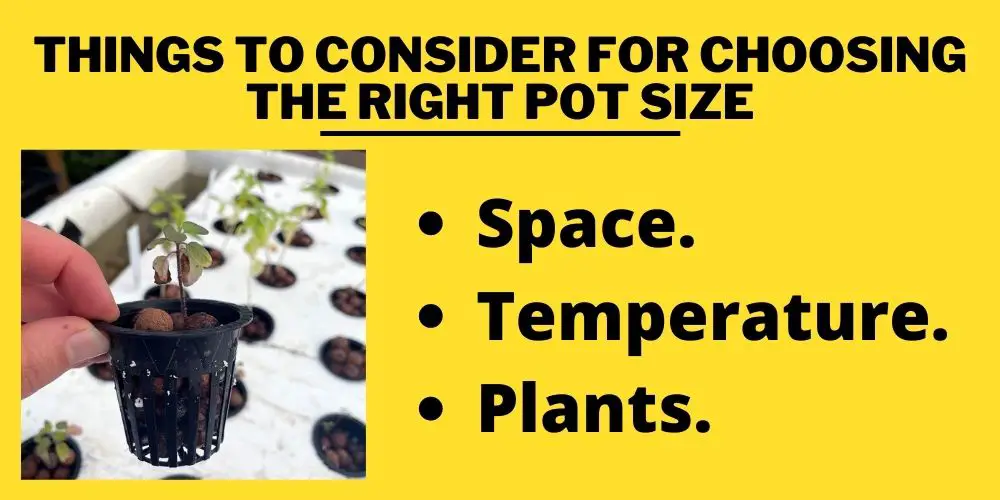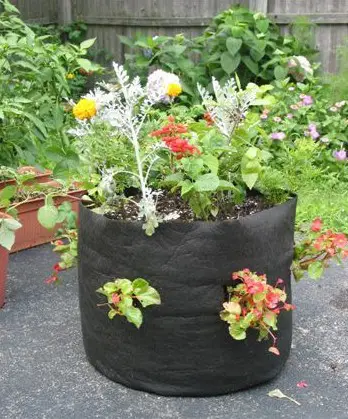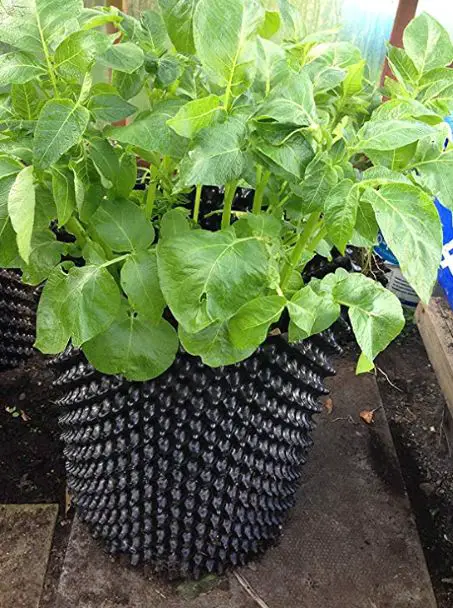It’s a known fact that pots are equally important to maintain a hydroponic system effectively.
But, does pot size matter in hydroponics?
Well, choosing the right pot size for your hydroponically grown plants is crucial. If the pots are too small, your plant’s root system could become suffocated and rot out.
On the other hand, if the pots are too big, you risk having the nutrients dissipate before they even reach the roots.
If this is the case, then your plants will be malnourished and, as a result, wilt and die. There are a few things to consider when deciding which size to go for.

In this article, we will explore the impact of pot size on hydroponic plant growth and provide insights into selecting the right pot size for optimal results.
Table of Contents
Does Pot Size Matter in Hydroponics?
The question of whether pot size matters in hydroponics has been a subject of debate among growers and researchers. Some argue that plants need space for root expansion, while others claim that tighter spacing can stimulate root growth.
The trick is finding that balance between maximizing space while still achieving sustainable growth. It’s common for traditional soil growers to throw their plants in much larger pots so they grow into them.
On the flip side, hydroponics requires a little more planning in that respect.
So, does pot size matter in hydroponics? Let’s answer that now.
Too Small a Pot
Having a pot too small for your plants can cause its roots to become curled up into themselves, leaving them to suffocate. Adding to this, the curled roots can potentially trap water in the pot’s base, leaving the roots and ultimately the plant to become waterlogged.
The knock-on effect is that sooner or later, your plant can rot and die as a result. It’s important to check that the roots aren’t trapped at all times during each stage.
Too Big a Pot
Comparatively, trying to grow your plants in a pot that is too big for its size also has its drawbacks.
For starters, the nutrients provided for the plants will dissipate and, as a result, get washed out with each irrigation period. The roots of the plants will want to try to move around the whole pot, searching for these nutrients to little or no avail.
This will leave them malnourished, which will see them perish if the issue is not corrected. Then there is maximizing space; too big pots for smaller plants in a small space aren’t efficient. As a grower, you would miss out on a huge yield with poor pot choices.
Things to Consider for Choosing the Right Pot Size
4 main factors can help you decide on the right size pot to plant your produce. These aspects should be carefully considered so that your plants are adequately nourished.
Consequently, they will produce consistent yields for you to enjoy providing they receive the right balance of the other growing elements.

Space
When it comes to space, some intricate planning needs to be undertaken right from the beginning. A lot of the decision-making will be based on the size of the area where you aim to set up your hydroponic system.
For example, if you plan to use an outdoor area, you will likely not have the same issues as indoor setup.
On the other hand, for indoor setup, you will need to utilize that area. Therefore, the size of the pots will need to be considered. You can only fit seedling-sized pots in a specific area and use another space for vegetative, flowering, etc. Height requirements of specific plants will also need to be taken into account.
Temperature
The temperature of your hydroponic system can also impact your plant’s growth within certain sized pots. For example, some lamps, such as the HID’s, can generate intense heat, causing the pots’ water and nutrient supply to evaporate faster.
The high-power halogens do have heat warnings, so it’s no surprise. If the system is set up with access to direct sunlight, this can have an even larger effect. Having a pot that is too small will see that the plant’s food supply dries up a lot quicker than with a bigger pot.
Of course, the lamp arrangement could be blamed, but pot size will strongly contribute to temperature. You can increase the flood time in an ebb and flow system as a solution.
Another option is to use a drip irrigation system to prevent the drying out of the plant. Cooler conditions can keep the roots too moist for too long, which can suffocate them, resulting in rotting out and ultimately death.
Plants
Pot size choice also depends on plant size and/or growth stage. Depending on which stage a plant goes through in its growth cycle, it will require different sized pots.
Different plants have varying space requirements and root systems. Some plants, such as tomatoes and cucumbers, have extensive root systems and benefit from larger pots.
On the other hand, plants like lettuce or herbs can do well in smaller pots. Understanding the specific needs of your plants will enable you to select the appropriate pot size.
Furthermore, as a plant grows, it will need more space to continue to maximize its development. Seedlings and cuttings are more suited to 4-inch pots. As the roots establish themselves, you can transfer them to a bigger size of around 6-12 inches to continue their next stage.
Nutrient uptake and availability
Pot size directly impacts nutrient uptake in hydroponic systems. Larger pots hold more nutrient solution, which can provide a reserve for the plants, reducing the risk of nutrient deficiencies.
However, it’s crucial to maintain the right nutrient balance and avoid over- or underfeeding the plants, regardless of pot size.
Oxygenation and root development
In hydroponics, oxygen plays a vital role in root health and development. Pot size affects the oxygen supply to the roots, as larger pots tend to have more oxygen available.
Adequate oxygenation promotes root growth and prevents diseases caused by poor aeration. Smaller pots, while restricting root expansion, can also stimulate root growth due to increased oxygen levels.
What are Smart Pots and Air Pots?
There are a couple of great pieces of pot technology that are worth sharing and going into more detail. Both of these pots can greatly increase your plants’ chances of growth and stability for a long time if used correctly.
Smart Pots
Smart Pots have been around since the early 1980s but have recently advanced in their construction and technology.
These containers are created using a soft porous fabric which allows the root system to grow through and establish themselves once re-planted from their current arrangement.
They grow outwards unrestricted. In contrast, traditional pots won’t allow this, and the roots can somewhat tangle within the more robust plastic.

The larger the roots, the better the fruits! Smart pots are manufactured in the same shape as traditional pots. They have a BPA-free rating which is perfect for those wanting to use them for food crops and/or more organic plants.
Pros
✅ Assist with drainage in the way that they allow water to drain through every piece of the fabric. On the other hand, traditional pots generally have a small drainage hole.
✅ Help regulate the temperatures for the root system. This will ensure that your plants won’t suffocate in the case of extreme heat. It reduces the risk of root rot which is another huge plus!
✅ Less fragile due to the flexibility of the fabric. This means no cracking and chipping as compared to traditional pots.
✅ Very large assortment of sizes, including custom.
Cons
❌ Larger plants are harder to transport because not all sizes include handles. They can become floppy and awkward to maneuver.
❌ More expensive compared to traditional pots. In most cases, you generally pay for what you get.
❌ Cleaning these fabrics requires a little extra elbow grease. A second washing machine would come in handy here.
Air Pots
Air pots are a pot used to help train a plant’s roots within the pot. They are constructed using 100% recycled perforated plastic. They are the same shape as traditional pots with holes located around all sides.
They have built-in plastic screws that hold the pots together, wrapped around an aerated base.
The base is built just off the ground to promote root growth outwards.
The purpose of these pots is that the roots will grow out of the holes and are ‘air pruned’ as roots don’t like to grow in air.
In other words, the air dehydrates the tip and sees them disappear.
Therefore, you’re encouraging them to become more robust.
Consequently, when upsizing and replanting, the roots will have the base strength to grow a lot easier within their new environment.

Pros
✅ Assist with aeration and drainage. This allows good bacteria to release more and better quality nutrients to the plant. It’s also not easy to flood this type of pot due to all the holes and open base. This fact alone helps to reduce root rot.
✅ More roots allow the intake of more nutrients and water, which as a result, stimulate faster growth.
✅ The extremely high growth success rate.
Cons
❌ The process can take some time to establish this really strong root system. It’s a trade-off, though, as the root system it creates is hard to emulate using traditional pots.
❌ Your growing medium can dry out faster as the top-quality aeration system is in force. As the water dries up, so does your nutrient supply which can hinder growth. A more frequent watering schedule is required.
Frequently Asked Questions (FAQs)
Can I put a small plant in a large pot?
Of course, it is physically possible to have a small plant growing in a larger pot, but it’s not ideal, and here’s why. If you give the smaller plant what you think to be an ample amount of water, the bigger pot will hold the water within the soil.
As a result, the soil becomes soggy and causes root rot. Not only that, but the plant will spend all of its energy created by nutrients to build a much bigger root system than required for its size. Consequently, the plants’ focus on foliage and flowers are minimal. So essentially, the larger pot size stunts the overall growth of the plant.
What do you put in hydroponic pots?
There are many types of plants that can be put into hydroponic pots. You can start with seedlings, clones, and cuttings. During each growth cycle stage, the plant sizes will change, as will the pots required for these plants.
Some of the best plants to grow are small root vegetables, various flower species, leafy greens, and herbs. Then you also have different types of growing mediums such as grow sponges, clay pebbles, rock wool, and clean gravel, to name a few.
Can you reuse smart pots?
A smart pot is reusable, tried, and tested! They can be sterilized in a washing machine using a recommended sterilization solution. A decent quality solution needs to be able to neutralize bacteria.
Once washed, it’s a good idea to give them a really good rinse to remove any of the solutions that may have soaked into the fabric of the pot.
If you have multiple or larger pots, taking them to a laundromat is a great option but be sure to rid the pots of any leftover soil. Make sure to dry them properly. Do not use a drying machine. Hang them up, and air dries them instead.
Does pot size matter in hydroponics for all plant types?
Pot size does matter, but the optimal size varies depending on the plant species and growth characteristics. Larger plants with extensive root systems generally require larger pots, while smaller plants can thrive in smaller pots.
How does pot size affect plant yield and harvest?
Pot size influences plant growth and overall yield. Larger pots can accommodate larger plant sizes and root systems, allowing for higher nutrient uptake and potentially leading to larger harvests. However, it’s crucial to maintain optimal nutrient levels and avoid overcrowding to maximize the yield.
Conclusion
Pot size does matter in hydroponics as it directly affects plant growth and development.
By considering factors such as plant species, nutrient uptake, and root oxygenation, you can determine the appropriate pot size for your hydroponic system.
Understanding the advantages and limitations of small, medium, and large pot sizes will help you optimize plant health and maximize yields in your hydroponic garden.
Select the right pot size and witness the flourishing growth of your plants in the world of hydroponics.


